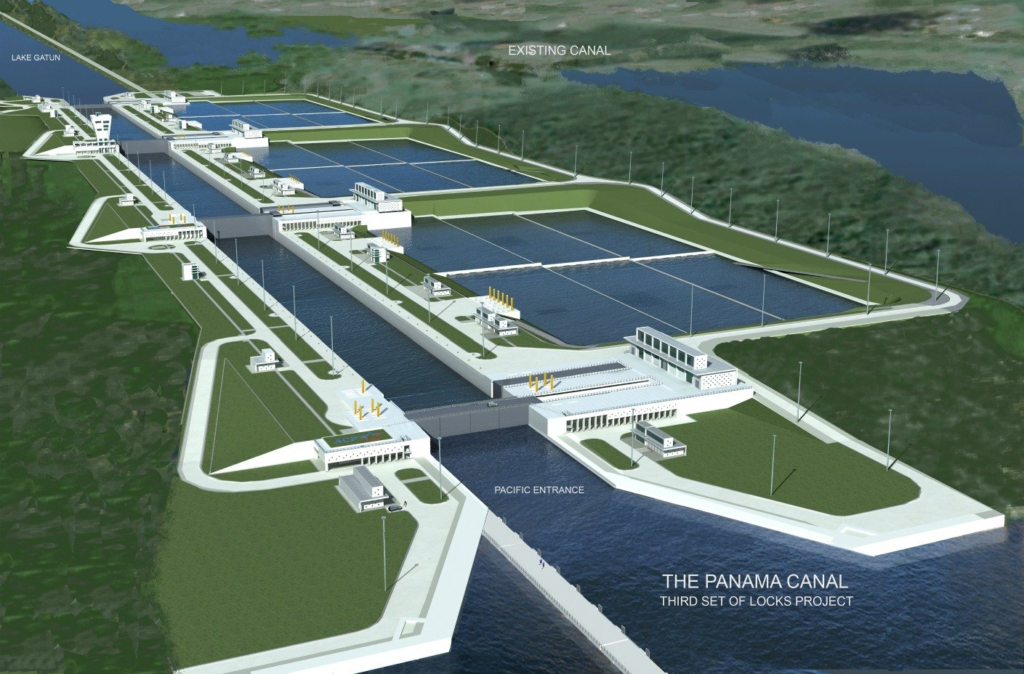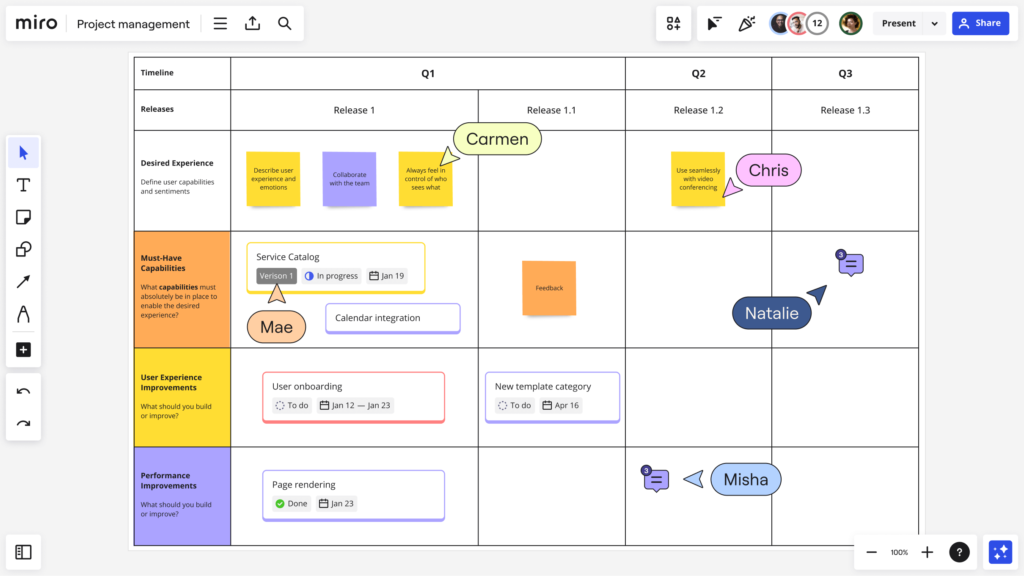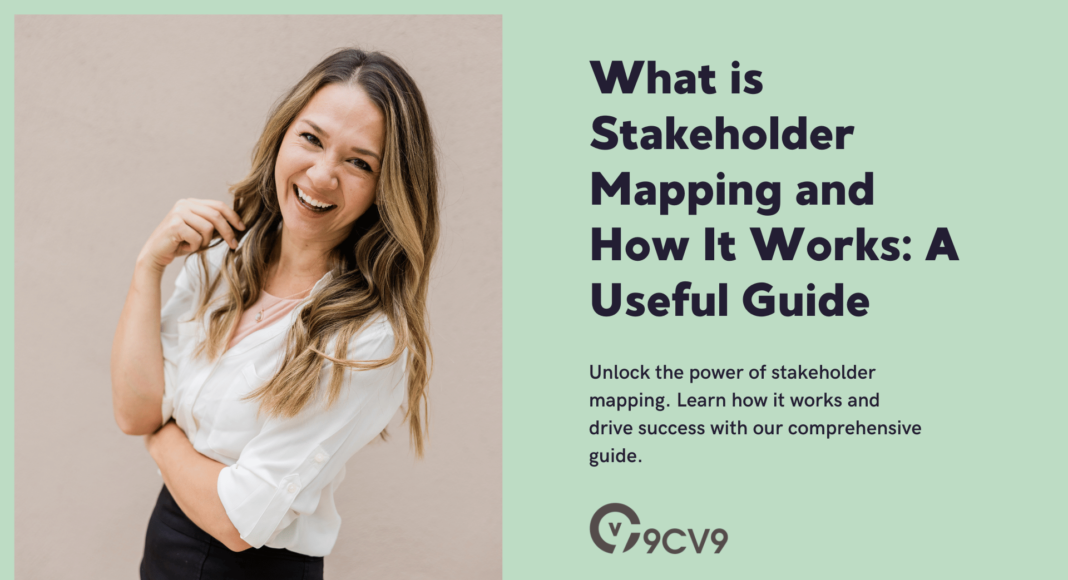Key Takeaways
- Empower Decision-Making: Stakeholder mapping equips you to make informed decisions by understanding the diverse interests and influences shaping your project or initiative.
- Foster Collaboration: By identifying and engaging stakeholders, you can build trust, mitigate conflicts, and foster productive relationships to drive project success.
- Navigate Complexity: Stakeholder mapping provides a structured framework to navigate the complexities of stakeholder landscapes, enabling you to anticipate risks, seize opportunities, and achieve desired outcomes.
In the dynamic landscape of modern businesses, projects, and community initiatives, success hinges not only on internal strategies and execution but also on the ability to navigate the intricate web of external stakeholders.
These stakeholders, ranging from customers and investors to government bodies and local communities, wield varying degrees of influence and interest in the endeavors we undertake.
Understanding their perspectives, concerns, and potential impact is paramount for fostering constructive relationships, mitigating risks, and driving sustainable outcomes.
This is where the practice of stakeholder mapping emerges as a pivotal tool for organizations and individuals alike.

Welcome to our comprehensive guide on stakeholder mapping – an essential compass in the realm of strategic planning, project management, and beyond.
Whether you’re a seasoned executive, a budding entrepreneur, a project manager, or a community organizer, this guide aims to demystify the intricacies of stakeholder mapping, empowering you to navigate the complex landscape of stakeholder interactions with confidence and clarity.
But first, let’s address the fundamental question: What exactly is stakeholder mapping, and why does it matter?
Stakeholder mapping, in its essence, is the systematic process of identifying, analyzing, and prioritizing the diverse array of individuals, groups, and organizations that have a stake in a particular project, decision, or initiative.
These stakeholders can exert influence, either directly or indirectly, on the outcomes and success of the endeavor.
By mapping out these stakeholders and understanding their interests, concerns, and power dynamics, stakeholders can proactively engage with them, anticipate potential challenges, and harness their support to drive positive outcomes.
At its core, stakeholder mapping serves as a strategic roadmap, guiding organizations through the maze of stakeholder relationships and enabling them to make informed decisions that align with the broader interests of all involved parties.
Whether you’re launching a new product, embarking on a community development project, or navigating a complex regulatory landscape, stakeholder mapping provides a structured framework for stakeholder engagement, communication, and collaboration.
Throughout this guide, we’ll delve deep into the intricacies of stakeholder mapping, exploring its underlying principles, practical methodologies, and real-world applications across various contexts.
From identifying key stakeholders and assessing their interests to developing tailored engagement strategies and mitigating conflicts, we’ll equip you with the tools and insights needed to master the art of stakeholder mapping.
But our journey doesn’t stop there.
We’ll also explore the challenges and pitfalls inherent in stakeholder mapping, offering strategies for overcoming resistance, navigating power dynamics, and adapting to evolving stakeholder landscapes.
Moreover, we’ll provide a curated selection of tools, resources, and best practices to support your stakeholder mapping endeavors, from innovative digital platforms to time-tested templates and techniques.
Whether you’re a business leader seeking to enhance stakeholder engagement, a project manager striving for effective collaboration, or a changemaker driving social impact, this guide is your definitive roadmap to unlocking the power of stakeholder mapping.
So, join us as we embark on this enlightening journey, and let’s navigate the complex terrain of stakeholder relationships together, one map at a time.
Before we venture further into this article, we like to share who we are and what we do.
About 9cv9
9cv9 is a business tech startup based in Singapore and Asia, with a strong presence all over the world.
With over eight years of startup and business experience, and being highly involved in connecting with thousands of companies and startups, the 9cv9 team has listed some important learning points in this overview of What is Stakeholder Mapping and How It Works: A Useful Guide.
If your company needs recruitment and headhunting services to hire top-quality employees, you can use 9cv9 headhunting and recruitment services to hire top talents and candidates. Find out more here, or send over an email to [email protected].
Or just post 1 free job posting here at 9cv9 Hiring Portal in under 10 minutes.
What is Stakeholder Mapping and How It Works: A Useful Guide
- Understanding Stakeholder Mapping
- The Process of Stakeholder Mapping
- Implementing Stakeholder Mapping in Various Contexts
- Overcoming Challenges and Pitfalls
- Tools and Resources for Stakeholder Mapping
1. Understanding Stakeholder Mapping
In the realm of strategic planning and project management, understanding stakeholder mapping is akin to wielding a compass in uncharted territory.
This section delves deep into the core concepts of stakeholder mapping, elucidating its significance, key components, and practical applications through real-world examples.

Defining Stakeholder Mapping: Concept and Purpose
- Definition: Stakeholder mapping is a strategic process that involves identifying, analyzing, and prioritizing individuals, groups, or organizations that have a vested interest in a project, decision, or initiative.
- Purpose:
- Enhanced Decision-Making: By comprehensively mapping stakeholders, organizations can make informed decisions that align with the broader interests of all involved parties.
- Improved Communication and Engagement: Stakeholder mapping facilitates effective communication and engagement strategies tailored to the needs and preferences of various stakeholders.
- Risk Mitigation: Identifying potential risks and conflicts early on enables proactive measures to mitigate their impact and ensure project success.
Key Components of Stakeholder Mapping
- Identifying Stakeholders
- Primary Stakeholders: Directly impacted by the project or decision.
- Secondary Stakeholders: Indirectly affected or have a peripheral interest.
- Example: In a corporate merger, primary stakeholders include employees, shareholders, and customers, while secondary stakeholders may include suppliers, regulatory bodies, and local communities.
- Analyzing Stakeholder Interests and Influence
- Power-Interest Grid: Assessing stakeholders based on their level of influence and interest in the project.
- Salience Model: Evaluating stakeholders based on their power, legitimacy, and urgency.
- Example: A government agency with high power and legitimacy may have significant influence over project outcomes, warranting proactive engagement and alignment with their interests.
- Prioritizing Stakeholders
- High-Priority Stakeholders: Those with significant influence or impact on the project’s success.
- Low-Priority Stakeholders: Individuals or groups with minimal influence or interest.
- Example: In a community development project, local residents and advocacy groups may be considered high-priority stakeholders due to their direct impact on project acceptance and sustainability.
Benefits of Stakeholder Mapping
- Enhancing Decision-Making Processes
- By considering diverse stakeholder perspectives, organizations can make decisions that balance conflicting interests and maximize positive outcomes.
- Improving Communication and Engagement
- Tailored communication strategies foster trust and collaboration, enhancing stakeholder buy-in and support.
- Mitigating Risks and Conflicts
- Proactive identification of potential risks and conflicts enables organizations to implement mitigation strategies and prevent project derailment.
Real-Life Examples and Case Studies
- Example 1: The Panama Canal Expansion Project
- Stakeholder mapping played a pivotal role in the successful execution of the Panama Canal Expansion Project. By identifying and engaging with diverse stakeholders, including government agencies, environmental groups, and local communities, project organizers navigated complex regulatory challenges and secured necessary approvals.
- Example 2: Corporate Social Responsibility Initiatives
- Companies leveraging stakeholder mapping in their corporate social responsibility (CSR) initiatives can align their philanthropic efforts with the interests and priorities of key stakeholders, thereby maximizing social impact and enhancing brand reputation.

This comprehensive understanding of stakeholder mapping sets the stage for effective stakeholder engagement and decision-making, empowering organizations to navigate complex stakeholder landscapes with confidence and clarity.
2. The Process of Stakeholder Mapping
Stakeholder mapping is not merely a one-time exercise but rather an iterative process that evolves alongside the project or initiative it supports.
This section outlines a step-by-step guide to stakeholder mapping, accompanied by practical methodologies and real-world examples to illustrate its application in various contexts.
Step-by-Step Guide
- Setting Objectives and Scope
- Clearly define the purpose and scope of the stakeholder mapping exercise, including the project’s goals, key deliverables, and timelines.
- Establish criteria for stakeholder prioritization and engagement based on project objectives and organizational priorities.
- Example: Before embarking on a sustainability initiative, a company may define objectives such as reducing carbon emissions, improving supply chain transparency, and enhancing community relations.
- Identifying Stakeholders
- Compile a comprehensive list of stakeholders who may be impacted by or have an influence on the project.
- Consider internal and external stakeholders across various levels of the organization and its ecosystem.
- Example: In a construction project, stakeholders may include investors, regulatory agencies, local residents, environmental groups, suppliers, and subcontractors.
- Analyzing Stakeholder Characteristics
- Assess stakeholders based on their level of influence, power, interest, and proximity to the project.
- Utilize tools such as stakeholder matrices, power-interest grids, or influence mapping techniques to categorize stakeholders.
- Example: A stakeholder with high power and high interest, such as a government regulator, may require frequent updates and close collaboration throughout the project lifecycle.
- Mapping Stakeholder Relationships
- Identify interdependencies and relationships between stakeholders, considering alliances, conflicts, and shared objectives.
- Visualize stakeholder relationships using mapping tools or diagrams to understand the network of interactions.
- Example: In a public infrastructure project, stakeholders may form alliances to advocate for shared interests, such as improved transportation infrastructure, while competing for resources and influence.
- Prioritizing Stakeholders
- Prioritize stakeholders based on their level of influence, impact on project success, and urgency of engagement.
- Allocate resources and efforts accordingly, focusing on high-priority stakeholders who have the greatest potential to affect project outcomes.
- Example: In a corporate restructuring initiative, key stakeholders such as top management, employees’ unions, and major shareholders may be prioritized for intensive engagement and communication.
- Developing Engagement Strategies
- Tailor communication and engagement strategies to meet the needs and preferences of different stakeholder groups.
- Utilize a variety of communication channels and platforms to reach stakeholders effectively.
- Example: For community engagement in a renewable energy project, organizers may conduct town hall meetings, distribute informational materials, and establish online forums to solicit feedback and address concerns.
Tools and Techniques for Effective Mapping
- Stakeholder Identification Matrices
- Matrix-based tools facilitate the systematic identification and categorization of stakeholders based on relevant criteria.
- Examples include the Stakeholder Salience Model and the Power-Interest Grid.
- Power-Interest Grids
- This tool categorizes stakeholders based on their level of influence (power) and interest in the project, guiding prioritization efforts.
- Influence Mapping
- Influence mapping techniques visualize the relationships and dynamics between stakeholders, helping to identify key influencers and decision-makers.
- SWOT Analysis
- SWOT (Strengths, Weaknesses, Opportunities, Threats) analysis can be applied to stakeholders to assess their potential impact on the project and identify areas for strategic engagement.
Real-Life Examples and Case Studies
- Example 1: The London 2012 Olympics
- Stakeholder mapping played a crucial role in the success of the London 2012 Olympics. Organizers engaged with a diverse array of stakeholders, including government agencies, local communities, sponsors, and athletes, to ensure seamless coordination and support for the event.
- Example 2: Sustainable Development Goals (SDGs)
- The United Nations’ Sustainable Development Goals (SDGs) initiative involves extensive stakeholder mapping to mobilize support and collaboration from governments, businesses, civil society organizations, and citizens worldwide.

By following this structured process of stakeholder mapping and leveraging relevant tools and techniques, organizations can effectively navigate complex stakeholder landscapes, foster constructive relationships, and drive positive outcomes for projects and initiatives.
3. Implementing Stakeholder Mapping in Various Contexts
Stakeholder mapping is a versatile tool that can be applied across a wide range of contexts, from business and project management to public policy and community development.
This section explores how stakeholder mapping can be effectively implemented in diverse settings, accompanied by real-world examples to illustrate its practical applications.
Business and Corporate Settings
- Strategic Planning and Decision-Making:
- Stakeholder mapping aids businesses in identifying key stakeholders, such as customers, investors, employees, and regulatory bodies, and understanding their interests and concerns.
- By aligning business strategies with stakeholder expectations, companies can enhance their reputation, mitigate risks, and drive long-term value creation.
- Example: A multinational corporation conducting stakeholder mapping as part of its sustainability strategy may identify environmental advocacy groups as influential stakeholders and develop initiatives to address their concerns, such as reducing carbon emissions or promoting eco-friendly practices.
- Mergers and Acquisitions:
- In merger and acquisition transactions, stakeholder mapping helps identify stakeholders from both organizations and assess their potential impact on the deal’s success.
- Understanding the interests of various stakeholders, including employees, shareholders, customers, and regulatory agencies, is critical for managing potential conflicts and securing stakeholder support.
- Example: During a merger between two pharmaceutical companies, stakeholder mapping reveals potential regulatory hurdles and antitrust concerns, prompting proactive engagement with relevant government agencies to expedite the approval process.
Project Management and Planning
- Infrastructure Development:
- Stakeholder mapping is integral to infrastructure projects, such as transportation networks, energy facilities, and urban redevelopment initiatives.
- By engaging with stakeholders, including local residents, government agencies, environmental groups, and business owners, project managers can address community concerns, obtain necessary permits, and ensure project acceptance and sustainability.
- Example: In the construction of a new airport, stakeholder mapping identifies neighboring communities, environmental conservation areas, and regulatory agencies as key stakeholders. Project planners engage with these stakeholders to mitigate noise pollution, protect wildlife habitats, and comply with environmental regulations.
- Product Development:
- Stakeholder mapping informs product development processes by identifying and prioritizing stakeholders, such as customers, suppliers, distributors, and industry regulators.
- By incorporating stakeholder feedback into product design and innovation, companies can enhance product-market fit, increase customer satisfaction, and gain a competitive edge.
- Example: A technology company conducting stakeholder mapping for a new software product identifies potential users, industry experts, and regulatory authorities as key stakeholders. Through user research and feedback sessions, the company iteratively refines the product features and functionality to meet stakeholder needs and expectations.
Public Policy and Government Initiatives
- Policy Formulation and Implementation:
- Stakeholder mapping informs public policy processes by identifying and engaging with diverse stakeholders, including government agencies, advocacy groups, industry associations, and community representatives.
- By soliciting input from stakeholders and incorporating their perspectives into policy decisions, governments can enhance policy effectiveness, legitimacy, and public trust.
- Example: In the development of environmental regulations, stakeholder mapping identifies stakeholders such as environmental NGOs, industry lobbyists, scientific experts, and affected communities. Government agencies engage with these stakeholders through public consultations, stakeholder meetings, and policy forums to balance competing interests and craft regulations that address environmental concerns while supporting economic growth.
- Community Development and Urban Planning:
- Stakeholder mapping is instrumental in community development and urban planning initiatives aimed at improving quality of life, infrastructure, and public services.
- By involving diverse stakeholders, including residents, businesses, nonprofit organizations, and local government agencies, planners can create inclusive, sustainable, and resilient communities.
- Example: In a city revitalization project, stakeholder mapping identifies residents, business owners, city officials, urban planners, and community organizations as key stakeholders. Through collaborative planning processes, stakeholders co-create a vision for the city’s future, prioritize development projects, and allocate resources to address community needs and aspirations.
Nonprofit Organizations and Community Development
- Social Impact Initiatives:
- Nonprofit organizations leverage stakeholder mapping to identify beneficiaries, donors, volunteers, partner organizations, and other stakeholders involved in social impact initiatives.
- By understanding stakeholder needs, preferences, and resources, nonprofits can design and implement programs that maximize social value and achieve meaningful outcomes.
- Example: A humanitarian organization conducting stakeholder mapping for a refugee assistance program identifies refugees, host communities, government agencies, donors, and humanitarian aid organizations as key stakeholders. Through needs assessments, stakeholder consultations, and partnerships, the organization delivers targeted aid, services, and advocacy efforts to support refugee integration and wellbeing.
- Community Engagement and Empowerment:
- Stakeholder mapping empowers communities to identify, prioritize, and address local issues and challenges through participatory decision-making processes.
- By fostering collaboration among diverse stakeholders, including residents, grassroots organizations, government agencies, and businesses, communities can mobilize resources, build capacity, and drive sustainable development.
- Example: In a grassroots community development project, stakeholder mapping identifies residents, community leaders, local businesses, government officials, and NGOs as key stakeholders. Through community meetings, workshops, and consensus-building exercises, stakeholders co-design and implement initiatives such as neighborhood revitalization, youth programs, or environmental conservation projects to improve community well-being and resilience.
By implementing stakeholder mapping in diverse contexts, organizations and communities can foster collaboration, build trust, and drive positive change that benefits stakeholders and society as a whole.
4. Overcoming Challenges and Pitfalls
Stakeholder mapping, while a powerful tool for enhancing engagement and decision-making, is not without its challenges and pitfalls.
This section explores common obstacles encountered in stakeholder mapping endeavors and offers strategies for overcoming them, supplemented by real-world examples to illustrate effective problem-solving approaches.
Common Mistakes in Stakeholder Mapping
- Incomplete Stakeholder Identification:
- Failure to identify all relevant stakeholders can result in oversight of critical interests, leading to stakeholder dissatisfaction and project risks.
- Example: In a community development project, omitting key stakeholders such as marginalized groups or indigenous communities may result in exclusion and resistance to project implementation.
- Assumption of Homogeneity:
- Treating stakeholder groups as homogeneous entities overlooks internal diversity and varying interests within each group, leading to misaligned engagement strategies.
- Example: Assuming that all employees within a company share the same perspectives and preferences may result in ineffective communication and lack of buy-in for organizational changes.
- Static Mapping Approach:
- Failing to adapt stakeholder mapping efforts to evolving project dynamics and stakeholder relationships can render mapping exercises obsolete and irrelevant over time.
- Example: A project team using a static stakeholder map fails to update it following changes in project scope, leading to missed opportunities for collaboration with new stakeholders or addressing emerging risks.
Strategies for Addressing Resistance and Conflicts
- Transparent Communication:
- Open and honest communication fosters trust and transparency, enabling stakeholders to voice concerns and grievances openly and constructively.
- Example: In a contentious urban development project, project organizers hold regular town hall meetings to address community concerns, provide project updates, and solicit feedback, fostering greater community engagement and trust.
- Conflict Resolution Mechanisms:
- Establishing formal mechanisms for resolving conflicts and disputes among stakeholders facilitates constructive dialogue and consensus-building.
- Example: A stakeholder mediation process is implemented to address disagreements between environmental activists and industry representatives in a contentious infrastructure project, leading to mutually acceptable compromises and project approvals.
- Collaborative Decision-Making:
- Involving stakeholders in decision-making processes empowers them to take ownership of outcomes and enhances project legitimacy and acceptance.
- Example: A participatory budgeting process engages residents in allocating municipal funds for community projects, fostering civic engagement, and accountability in resource allocation decisions.
Adapting to Changing Stakeholder Dynamics
- Continuous Stakeholder Engagement:
- Regularly engaging with stakeholders throughout the project lifecycle ensures ongoing alignment with stakeholder interests and enables timely response to changing priorities.
- Example: A corporate sustainability initiative conducts annual stakeholder consultations to gather feedback on sustainability goals, performance, and priorities, enabling the company to adapt its strategies and initiatives accordingly.
- Monitoring and Evaluation:
- Implementing robust monitoring and evaluation mechanisms allows stakeholders to track progress, assess impact, and identify emerging issues or concerns.
- Example: A public infrastructure project establishes key performance indicators (KPIs) to measure project outcomes and regularly reports progress to stakeholders through public dashboards and performance reports.
- Flexibility and Adaptability:
- Maintaining flexibility and adaptability in stakeholder mapping processes enables organizations to respond effectively to unforeseen changes in stakeholder dynamics or project circumstances.
- Example: A project team facing unexpected stakeholder opposition revises its stakeholder engagement plan, reallocates resources to address stakeholder concerns, and adopts alternative strategies to build consensus and support for the project.
By proactively addressing challenges and pitfalls in stakeholder mapping, organizations can enhance stakeholder engagement, build trust, and increase the likelihood of project success.
Through transparent communication, conflict resolution mechanisms, and adaptability to changing stakeholder dynamics, stakeholders can collaborate effectively to achieve shared goals and positive outcomes.
5. Tools and Resources for Stakeholder Mapping
Stakeholder mapping, while conceptually straightforward, can benefit greatly from the utilization of specialized tools and resources designed to streamline the process and enhance its effectiveness.
This section explores a range of tools and resources available for stakeholder mapping, along with examples of their practical application in various contexts.
Digital Platforms and Software Solutions
- Stakeholder Mapping Software:
- Dedicated stakeholder mapping software offers comprehensive features for identifying, analyzing, and visualizing stakeholder relationships and dynamics.
- Examples include Miro and Stakeholdermap.com.
- Customer Relationship Management (CRM) Systems:
- CRM systems provide tools for managing customer and stakeholder interactions, tracking engagement activities, and segmenting stakeholders based on various criteria.
- Examples include Salesforce, HubSpot, and Zoho CRM.
- Social Network Analysis (SNA) Tools:
- SNA tools analyze the network of relationships between stakeholders, identifying key influencers, connectors, and communities within stakeholder networks.
- Examples include NodeXL, Gephi, and UCINet.

Templates and Guides for Effective Mapping
- Stakeholder Identification Matrices:
- Stakeholder identification matrices help organize stakeholders based on criteria such as influence, interest, power, and proximity to the project.
- Examples include Power-Interest Grids, Stakeholder Salience Models, and Influence-Interest Matrices.
- Stakeholder Mapping Templates:
- Pre-designed templates provide a structured framework for conducting stakeholder mapping exercises, guiding users through the process step-by-step.
- Examples include stakeholder mapping templates available in Microsoft Excel, Google Sheets, and project management software such as Trello or Asana.
- Stakeholder Engagement Guides:
- Comprehensive guides offer best practices, tips, and strategies for engaging with stakeholders effectively and building constructive relationships.
- Examples include guides published by organizations such as the International Association for Public Participation (IAP2) and the Project Management Institute (PMI).
Recommended Reading and Further Learning
- Books on Stakeholder Management:
- Books authored by experts in stakeholder management provide in-depth insights into stakeholder theory, strategies, and practical approaches.
- Examples include “Managing Stakeholder Expectations for Project Success” by Prakash Choudhary and “Stakeholder Theory: Concepts and Strategies” by R. Edward Freeman.
- Online Courses and Training Programs:
- Online courses and training programs offer structured learning experiences on stakeholder mapping, covering topics such as stakeholder identification, analysis, engagement, and conflict resolution.
- Examples include courses available on platforms like Coursera, LinkedIn Learning, and Udemy.
- Academic Journals and Research Papers:
- Academic journals and research papers provide scholarly insights and empirical studies on stakeholder mapping theory, methodologies, and case studies.
- Examples include journals such as the Journal of Business Ethics, the Journal of Management Studies, and the Journal of Stakeholder Management.
Case Studies and Practical Examples
- Corporate Sustainability Initiatives:
- Case studies of corporate sustainability initiatives showcase how companies engage with stakeholders to address environmental, social, and governance (ESG) issues.
- Example: Unilever’s Sustainable Living Plan involves stakeholder mapping to identify and prioritize sustainability goals, engage with diverse stakeholders, and track progress towards targets.
- Public Policy and Governance:
- Case studies of public policy and governance initiatives highlight stakeholder mapping practices in areas such as regulatory reform, public-private partnerships, and community development.
- Example: The World Bank’s stakeholder engagement framework includes stakeholder mapping as a key step in project design and implementation, ensuring inclusive decision-making and accountability.
- Community Development Projects:
- Case studies of community development projects demonstrate stakeholder mapping processes in grassroots initiatives aimed at improving livelihoods, infrastructure, and social services.
- Example: The Participatory Rural Appraisal (PRA) approach involves stakeholder mapping as a participatory tool for empowering communities to identify priorities, resources, and solutions for local development challenges.
By leveraging these tools, resources, and practical examples, stakeholders can enhance their stakeholder mapping efforts, foster collaboration, and drive positive outcomes in diverse contexts, from business and project management to public policy and community development.
Whether utilizing specialized software solutions, templates, recommended reading, or real-world case studies, stakeholders can gain valuable insights and guidance to navigate complex stakeholder landscapes effectively.
Conclusion
You’ve embarked on a transformative journey through the intricate world of stakeholder mapping, armed with knowledge, strategies, and practical tools to navigate the complexities of stakeholder relationships with confidence and clarity.
As we draw this comprehensive guide to a close, let’s reflect on the invaluable insights and actionable steps you’ve gained along the way.
Stakeholder mapping isn’t just another buzzword; it’s a powerful compass that guides organizations, projects, and initiatives towards success by illuminating the diverse array of individuals, groups, and organizations that have a stake in their outcomes.
By systematically identifying, analyzing, and prioritizing stakeholders, organizations can make informed decisions, enhance communication and engagement, and mitigate risks and conflicts, ultimately driving sustainable and impactful outcomes.
Throughout this guide, we’ve explored the fundamental concepts of stakeholder mapping, from defining its purpose and key components to outlining the step-by-step process of implementation.
We’ve delved into real-world examples across various contexts, from business and project management to public policy and community development, illustrating how stakeholder mapping can be applied effectively to achieve diverse goals and objectives.
We’ve also addressed common challenges and pitfalls in stakeholder mapping endeavors, offering strategies for overcoming resistance, resolving conflicts, and adapting to changing stakeholder dynamics.
By fostering transparent communication, implementing conflict resolution mechanisms, and maintaining flexibility and adaptability, stakeholders can navigate the complexities of stakeholder landscapes with resilience and perseverance.
Furthermore, we’ve explored a wealth of tools, resources, and recommended reading to support your stakeholder mapping efforts, from specialized software solutions and templates to online courses and case studies.
Whether you’re a seasoned professional or a novice explorer, these resources offer invaluable guidance and inspiration to enhance your stakeholder mapping practices and drive positive change in your endeavors.
As you embark on your stakeholder mapping journey, remember that success isn’t measured by the complexity of your maps or the number of stakeholders identified, but by the impact you create and the relationships you nurture along the way.
Embrace stakeholder mapping as a dynamic and iterative process, grounded in collaboration, empathy, and mutual respect for the diverse perspectives and interests of all stakeholders involved.
In closing, I encourage you to apply the principles and strategies outlined in this guide to your own stakeholder mapping endeavors, whether you’re leading a corporate initiative, managing a community project, or shaping public policy.
Together, let’s harness the power of stakeholder mapping to build a more inclusive, resilient, and sustainable future for all.
Thank you for joining us on this enlightening journey.
Here’s to unlocking the potential of stakeholder mapping and charting a course towards success, one stakeholder at a time.
If your company needs HR, hiring, or corporate services, you can use 9cv9 hiring and recruitment services. Book a consultation slot here, or send over an email to [email protected].
If you find this article useful, why not share it with your hiring manager and C-level suite friends and also leave a nice comment below?
We, at the 9cv9 Research Team, strive to bring the latest and most meaningful data, guides, and statistics to your doorstep.
To get access to top-quality guides, click over to 9cv9 Blog.
People Also Ask
What is stakeholder mapping?
Stakeholder mapping is a strategic process that involves identifying, analyzing, and prioritizing individuals, groups, or organizations with an interest in a project or initiative.
Why is stakeholder mapping important?
Stakeholder mapping helps organizations understand the perspectives, interests, and influence of stakeholders, enabling better decision-making, communication, and risk management.
How does stakeholder mapping work?
Stakeholder mapping works by systematically identifying stakeholders, analyzing their interests and influence, prioritizing them based on importance, and developing tailored engagement strategies.
Who are stakeholders in stakeholder mapping?
Stakeholders can include individuals, groups, organizations, or entities that are directly or indirectly affected by a project, decision, or initiative.
What are the benefits of stakeholder mapping?
Benefits of stakeholder mapping include enhanced decision-making, improved communication and engagement, and better risk management and conflict resolution.
When should stakeholder mapping be done?
Stakeholder mapping should ideally be conducted at the early stages of a project or initiative to identify stakeholders, understand their interests, and engage them effectively throughout the process.
Where is stakeholder mapping used?
Stakeholder mapping is used in various contexts, including business, project management, public policy, community development, and nonprofit organizations.
Can stakeholder mapping be applied in different industries?
Yes, stakeholder mapping can be applied across industries, including healthcare, education, finance, technology, and environmental conservation.
How do you identify stakeholders?
Stakeholders can be identified through stakeholder analysis, surveys, interviews, stakeholder mapping workshops, and consultation with subject matter experts.
What criteria are used to prioritize stakeholders?
Stakeholders can be prioritized based on factors such as their level of influence, interest, power, legitimacy, urgency, and potential impact on the project or initiative.
What tools are used for stakeholder mapping?
Tools for stakeholder mapping include stakeholder identification matrices, power-interest grids, influence mapping techniques, SWOT analysis, and stakeholder engagement software.
What are some common challenges in stakeholder mapping?
Common challenges in stakeholder mapping include incomplete stakeholder identification, assumption of homogeneity, static mapping approach, resistance and conflicts, and stakeholder dynamics.
How can organizations overcome challenges in stakeholder mapping?
Organizations can overcome challenges in stakeholder mapping by fostering transparent communication, implementing conflict resolution mechanisms, and maintaining flexibility and adaptability in stakeholder engagement strategies.
How do you engage stakeholders effectively?
Effective stakeholder engagement involves building trust, listening to stakeholder concerns, involving them in decision-making processes, providing timely and relevant information, and demonstrating commitment to their interests.
What are some examples of stakeholder mapping in real life?
Real-life examples of stakeholder mapping include corporate sustainability initiatives, public infrastructure projects, community development initiatives, public policy formulation, and stakeholder engagement in nonprofit organizations.
Is stakeholder mapping a one-time activity?
No, stakeholder mapping is an iterative process that evolves alongside the project or initiative, requiring ongoing engagement, monitoring, and adaptation to changing stakeholder dynamics.
How does stakeholder mapping contribute to project success?
Stakeholder mapping contributes to project success by ensuring stakeholder buy-in and support, minimizing conflicts and risks, enhancing communication and collaboration, and aligning project objectives with stakeholder interests.
Can stakeholder mapping help in managing project risks?
Yes, stakeholder mapping can help in managing project risks by identifying potential risks associated with stakeholders, such as resistance, conflicts, or lack of support, and developing strategies to mitigate them.
What role does stakeholder mapping play in strategic planning?
Stakeholder mapping plays a crucial role in strategic planning by informing decision-making processes, identifying opportunities and threats, aligning strategies with stakeholder interests, and enhancing organizational resilience and sustainability.
How can stakeholder mapping improve communication?
Stakeholder mapping improves communication by providing insights into stakeholder preferences, expectations, and communication preferences, enabling organizations to tailor their messages and engagement strategies accordingly.
How do you measure the effectiveness of stakeholder mapping?
The effectiveness of stakeholder mapping can be measured through indicators such as stakeholder satisfaction, level of stakeholder engagement, resolution of conflicts, achievement of project objectives, and positive project outcomes.
What are the limitations of stakeholder mapping?
Limitations of stakeholder mapping include subjective stakeholder assessments, difficulty in predicting stakeholder behavior, potential for stakeholder resistance or opposition, and resource-intensive nature of stakeholder engagement.
How can organizations ensure inclusivity in stakeholder mapping?
Organizations can ensure inclusivity in stakeholder mapping by actively seeking input from diverse stakeholder groups, including marginalized or underrepresented voices, and creating opportunities for meaningful participation and collaboration.
Can stakeholder mapping help in building partnerships?
Yes, stakeholder mapping can help in building partnerships by identifying potential collaborators, allies, or strategic partners who share common interests or objectives, and exploring opportunities for collaboration and mutual benefit.
How can stakeholders be engaged in decision-making processes?
Stakeholders can be engaged in decision-making processes through participatory approaches such as stakeholder consultations, workshops, focus groups, advisory committees, and co-design sessions, where their input and feedback are valued and incorporated into decision-making.
What are the ethical considerations in stakeholder mapping?
Ethical considerations in stakeholder mapping include ensuring transparency and informed consent, respecting stakeholder autonomy and confidentiality, avoiding conflicts of interest, and prioritizing the well-being and rights of stakeholders throughout the process.
How does stakeholder mapping contribute to corporate social responsibility (CSR)?
Stakeholder mapping contributes to CSR initiatives by identifying stakeholders affected by corporate activities, understanding their concerns and expectations, and integrating social and environmental considerations into business strategies and operations.































![Writing A Good CV [6 Tips To Improve Your CV] 6 Tips To Improve Your CV](https://blog.9cv9.com/wp-content/uploads/2020/06/2020-06-02-2-100x70.png)


